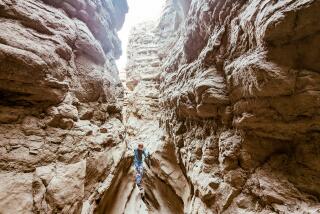Ease and Challenge of Maroon Bells
- Share via
For hikers, the Maroon Bells-Snowmass Wilderness is a Rocky Mountain high. Alpine meadows, shimmering aspen groves and ice-sculpted cliffs are some of the scenic attractions beckoning in the Colorado Rockies near Aspen.
Maroon Bells welcomes novice hikers with some easy mountain paths, and challenges experienced hikers with high mountain passes and a true wilderness adventure. You can take a narrated bus tour to the trail head and enjoy a box lunch from one of Aspen’s chichi restaurants, or you can rough it with a difficult Maroon Bells-Snowmass Wilderness trek, where the magnificent scenery will leave you as breathless as the thin alpine air.
Serious mountaineers will note that twin-peaked Maroon Bells boasts two of Colorado’s famed “fourteeners”: South Maroon Peak (14,156 feet) and North Maroon Peak (14,014 feet).
An 1870s U.S. Geological and Geographical Survey expedition noticed the reddish color and bell-like shapes and gave Maroon Bells their name. Traces of iron in the weathered rock give the peaks their distinctive color.
Wildflower-watchers will delight at the summertime color splashed about the Bells--pink and purple asters, bright red Indian paintbrush and purple-blue columbine, Colorado’s state flower.
Aspen has an altogether different vibe during the summer. Apres -ski season, prices for everything--from meals to accommodations--drop as quickly as the expert runs on Aspen Mountain. Pretensions drop away, too, and the town seems less a jet-set resort and more like a Western town, albeit a boutiqued one, perched on the edge of wilderness.
Summer is the season for the Aspen Music Festival, DanceAspen and Aspen Theatre in the Park. It’s also Aspen’s hiking season.
According to Cheryl Tatro, information officer for the Aspen office of the White River National Forest, hiking season for visitors begins in late May and lasts through October.
Getting to the Maroon Bells trail system by bus is half the fun. And a good thing, too, because Maroon Lake and environs are closed to auto traffic during most of the summer; in fact, the bus is the only way to go. The U.S. Forest Service, in order to protect the fragile Maroon Valley ecology, closed the road to cars some years ago.
Drivers from the Roaring Fork Transit Agency offer an enthusiastic lesson on the area’s human and natural history during the 30-minute journey from Aspen to Maroon Lake.
Buses to Maroon Bells depart Aspen every half-hour daily, 9 a.m. to 4:30 p.m. If you’re not lucky enough to snag one of Aspen’s very few, unregulated, all-day parking spaces, leave your car at the Rio Grande Parking Garage (50 cents an hour) at Mill and Main streets. A free shuttle bus or a short walk will bring you to the Rubey Park Transit Center for the bus tour.
Round-trip bus fare to the Bells is $3.50 for adults, $1.50 for seniors and children 6-16; kids 5 and under ride free. Buses run daily from June 20 to Sept. 7, plus weekends through the first weekend in October.
Before hitting the trail, Maroon Bells-bound hikers could pay a visit to the cappuccino bar at the Swiss Bakery or pick up some pate to go at Charcuterie.
Hikers can also take advantage of the Maroon Bells box lunch program. Selected Aspen restaurants offer lunches at a discount rate when you present your Maroon Bells bus ticket. Ask about the box lunch program when you buy your ticket at the transit center.
The hikes: Maroon Creek Trail (3 1/4 miles one way) begins at the east end of Maroon Lake. The often muddy path follows twisting Maroon Creek. Hikers can meander down Maroon Valley to East Maroon Portal, where there’s a bus stop.
Maroon Lake Scenic Trail (1 1/4 miles round trip) is a lake-side stroll that offers a close-up look at beaver dams. This gentle path meanders through a mountain meadow bedecked in summer with wildflowers, where two- to five-foot-tall green plants called miner’s candle seem to light the way. Columbine grows in profusion near the first bridge crossing, about half a mile from the trail head.
Beyond the lake and meadow, you can ascend Scenic Trail another mile through mixed aspen and evergreen forest. You’ll crest a short, steep hill and the trail splits. The left fork is a path leading along the west fork of Maroon to Crater Lake. The right fork is the Maroon Bells-Snowmass Trail bound for Buckskin Pass and Snowmass Village.
The trail flattens out as it reaches Crater Lake, another picture-perfect and perfect-for-a-picnic spot, with the gorgeous Maroon Bells providing a dramatic backdrop.
Maroon-Snowmass Trail (17 miles one way; 4,100-foot elevation gain) is a challenge for experienced hikers in top condition. This heart-stirring trail extends from the Snowmass Ski Area up and over 12,462-foot Buckskin Pass to Maroon Lake. Although the trail can be hiked from either direction, the preferred start point is Snowmass Village because transportation back to Aspen is much easier from the trail’s end at Maroon Lake.
To reach the trail head from Aspen, follow Colorado 82 west 6 1/2 miles to the Snowmass Village turnoff (Brush Creek Road). Drive 5 1/4 miles to Krabloonik Restaurant, then join the dirt Divide Road, following it to its end at the parking area for the Maroon-Snowmass Trail, also known as Snowmass Creek Trail.
The path follows a ranch road for a short time, then begins meandering with Snowmass Creek, occasionally venturing into the woods above the creek. After 6 creek-side miles, the path leaves Snowmass Creek and climbs steeply through forest and rocky terrain to a junction with the Maroon-Snowmass Trail, a quarter-mile from Snowmass Lake.
After taking a break at the lake (you’ve hiked almost exactly halfway, 8 1/2 miles), join the Maroon-Snowmass Trail for a brief descent into meadowland, then a steep ascent above the tree line.
You’ll get grand, over-the-shoulder views of Snowmass Mountain and Snowmass Lake as you tackle Buckskin Pass. Atop the pass, congratulate yourself for day-hiking a dozen miles. It’s all downhill from here. You’ll descend toward Willow Pass, pass through spruce-filled Minnehaha Gulch, then traipse through aspen groves and finally down to Crater Lake. Here you’ll join the popular path down to Maroon Lake and the bus back to Aspen.
Take a hike with John McKinney’s guidebook: “Walk Los Angeles: Adventures on the Urban Edge “ ($14.95). Send check or money order to Los Angeles Times Syndicate, Dept. 1, Times Mirror Square, Los Angeles 90053.
Rocky Mountains / Aspen, Colo. Where: Maroon Bells-Snowass Wilderness, White River National Forest Distance: 1-to 3 mile paths around Maroon Lake: 17 miles one way from Village to Maroon Lake. Terrain: Gentle valley surrounded by steep aspen-and evergreen-covered slopes. Highlights: Alpine lakes backed by magnificent red-rock cliffs of the Maroon Bells. Degree of difficulty: Easy to strenuous. Precautions: Take note of high-altitude hiking, quickly changing weather conditions. For more information: Contact White River National Forest, Aspen Ranger District, 806 W. Hallam, Aspen, Colo. 81611, (303) 925-3445. For general information about travel to Aspen, call the Aspen Visitors Center at (303) 925-5656.
More to Read
Sign up for The Wild
We’ll help you find the best places to hike, bike and run, as well as the perfect silent spots for meditation and yoga.
You may occasionally receive promotional content from the Los Angeles Times.






